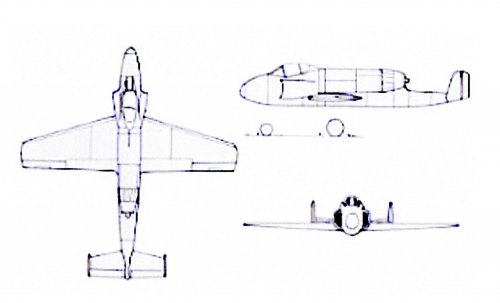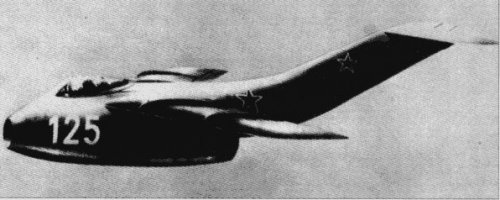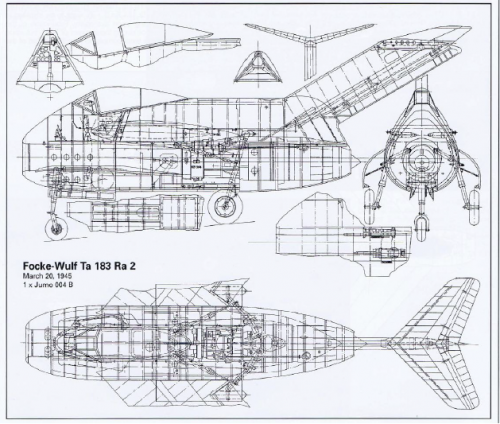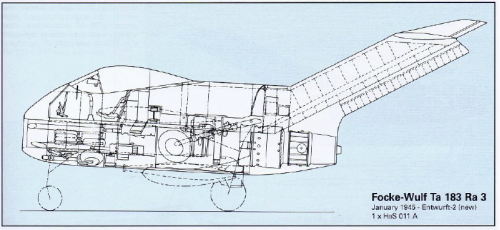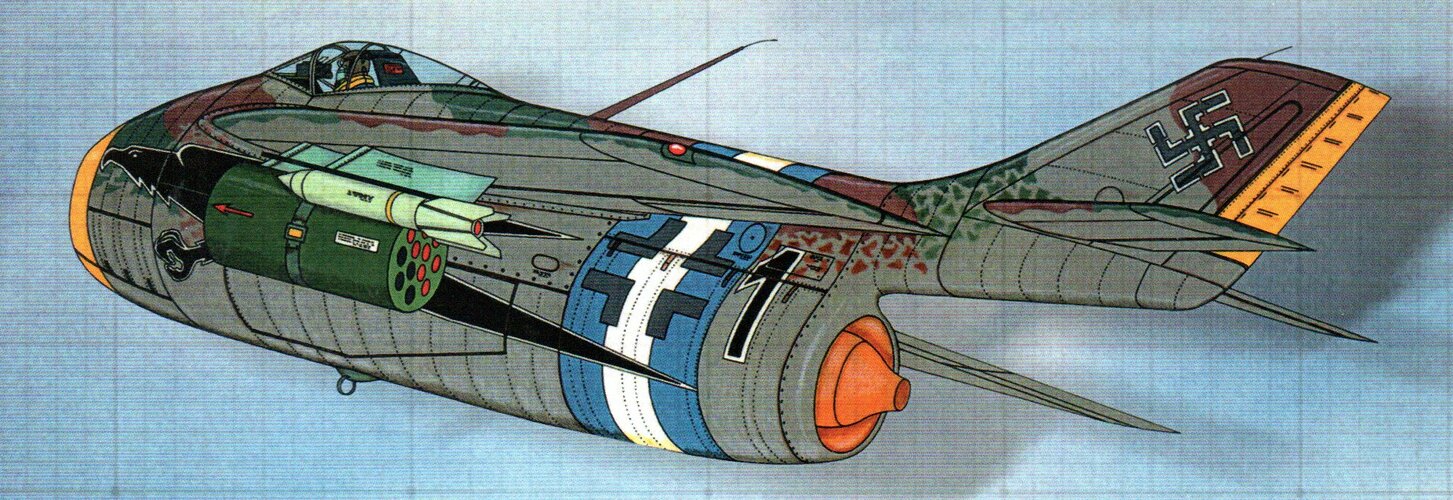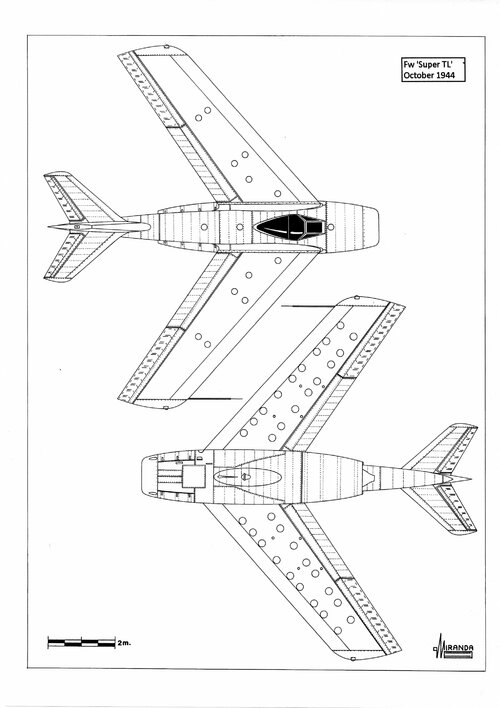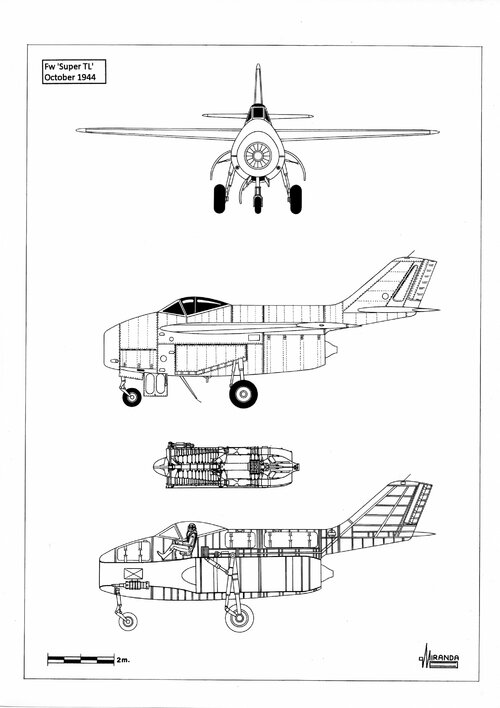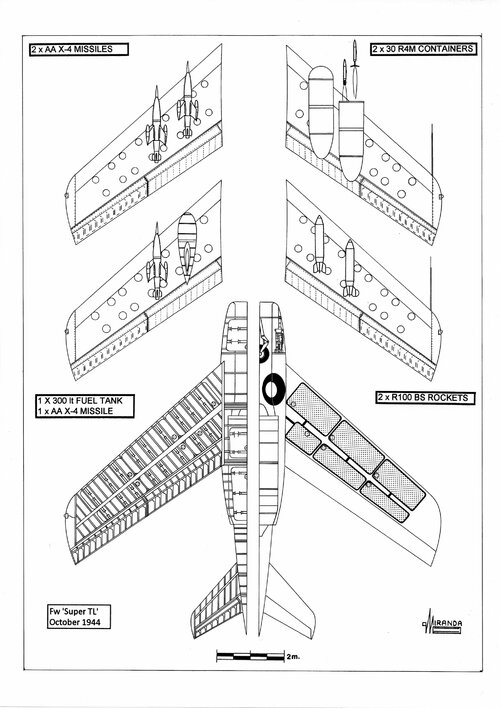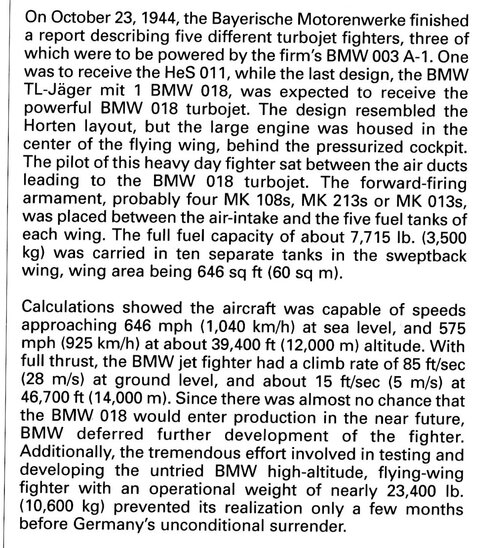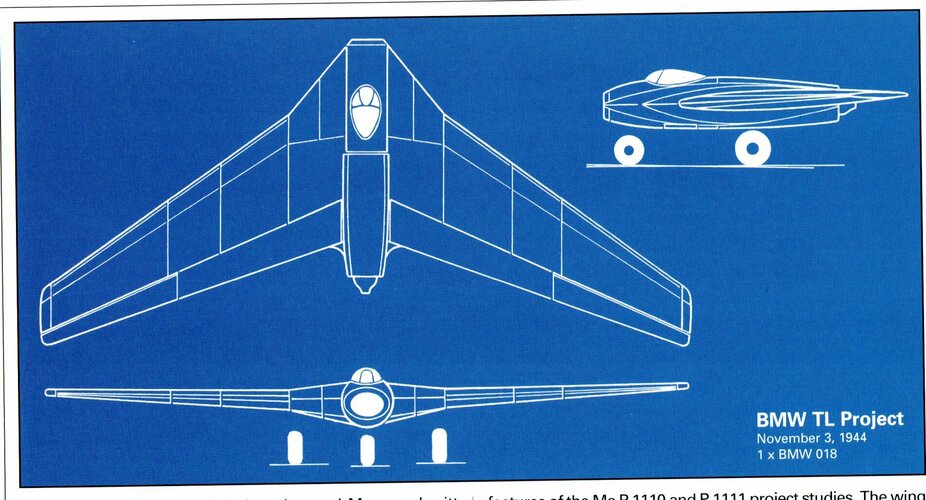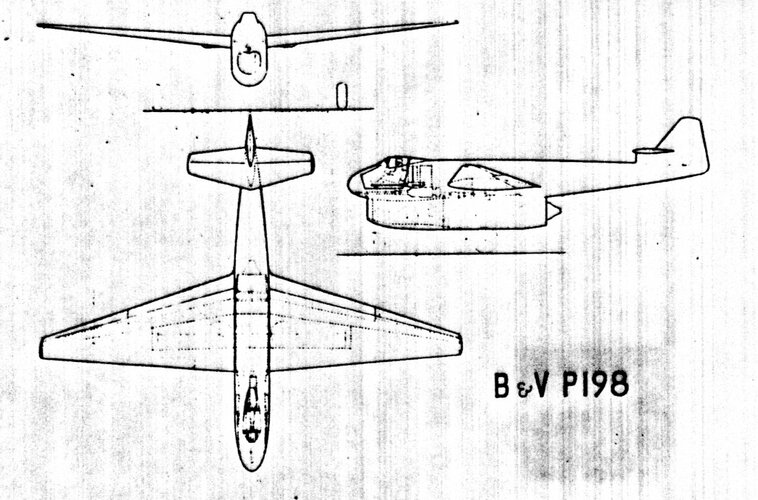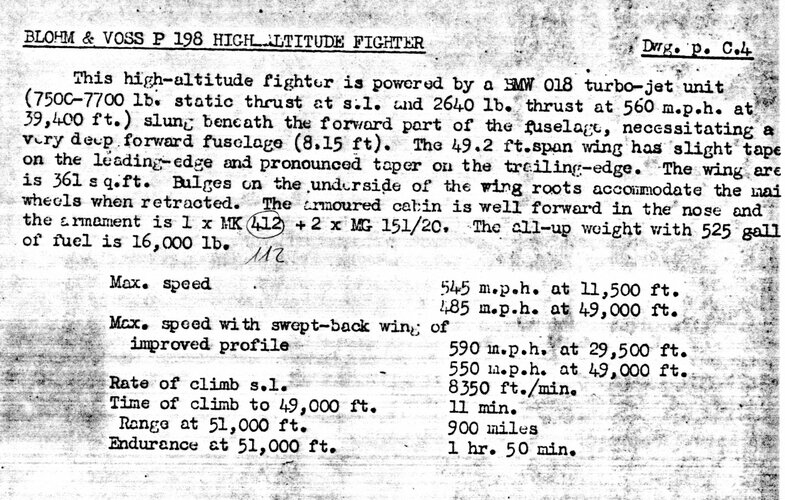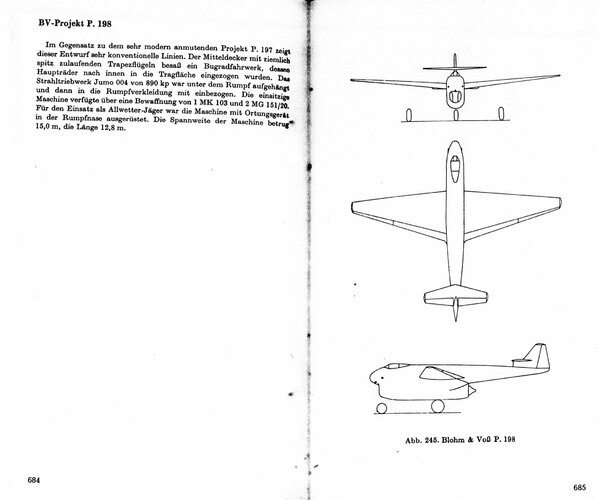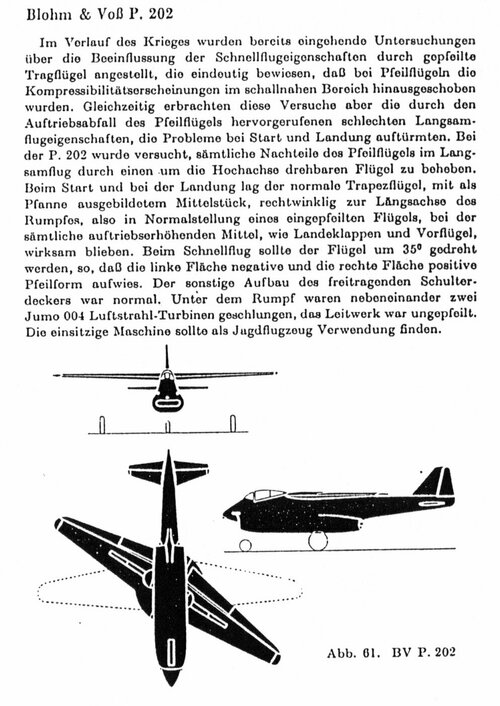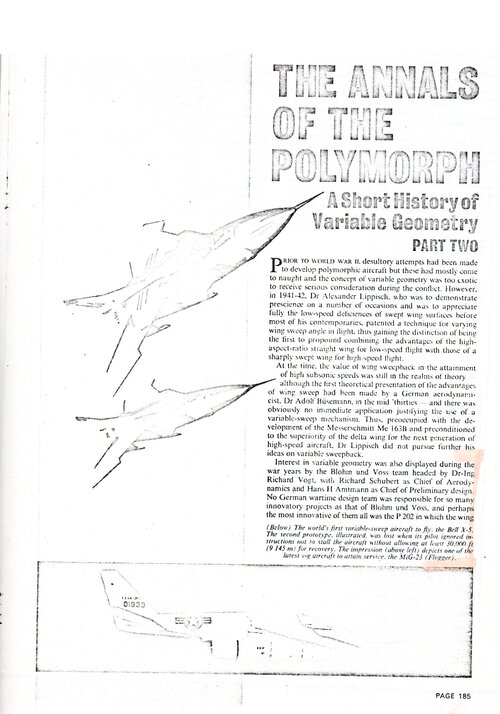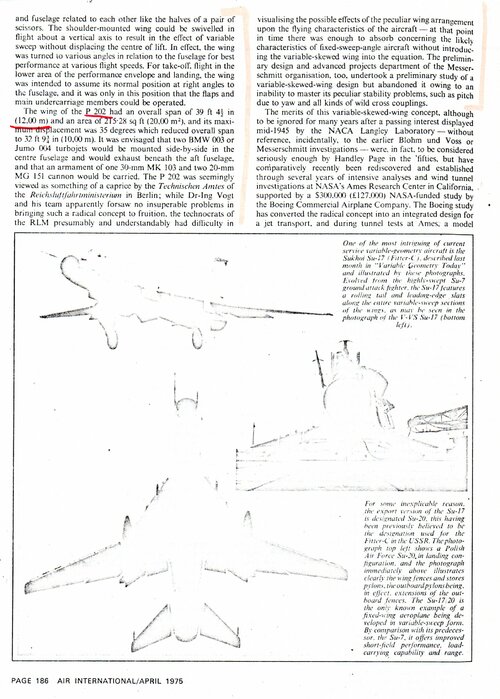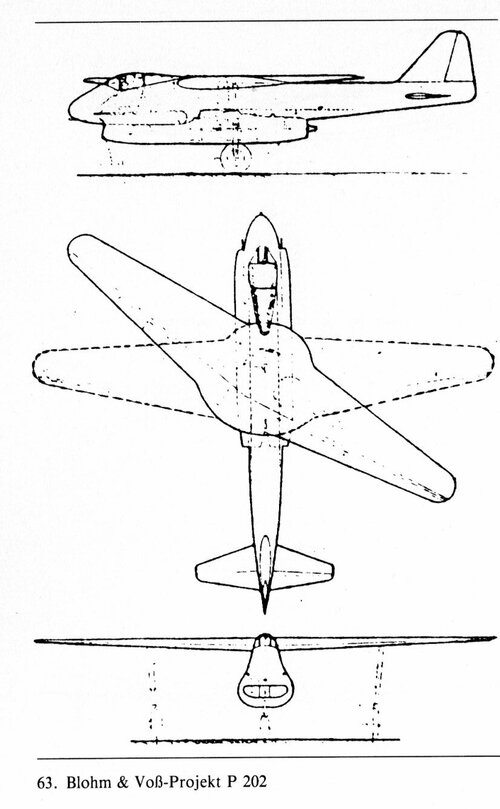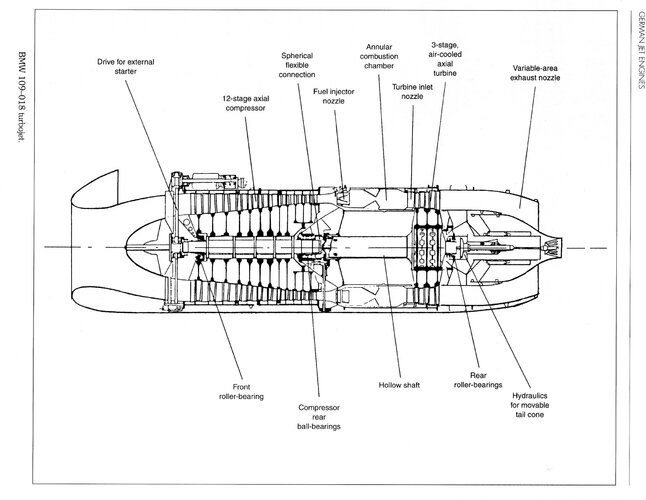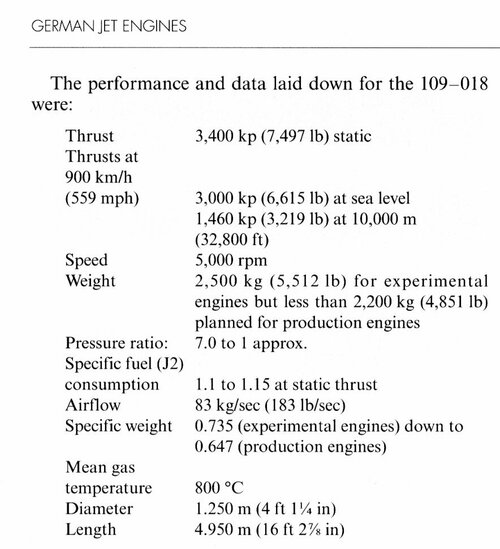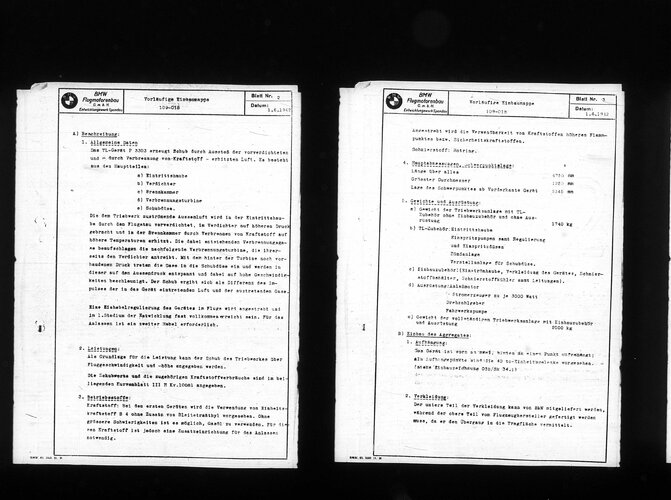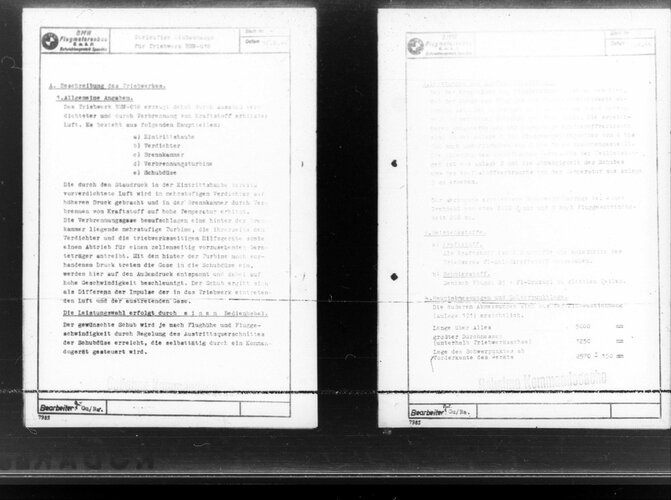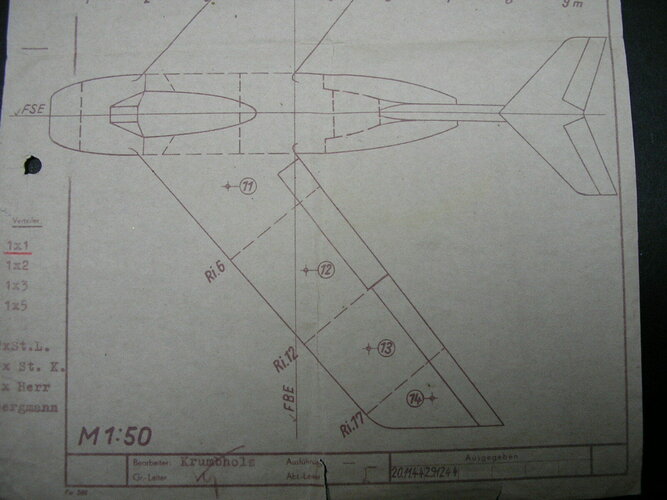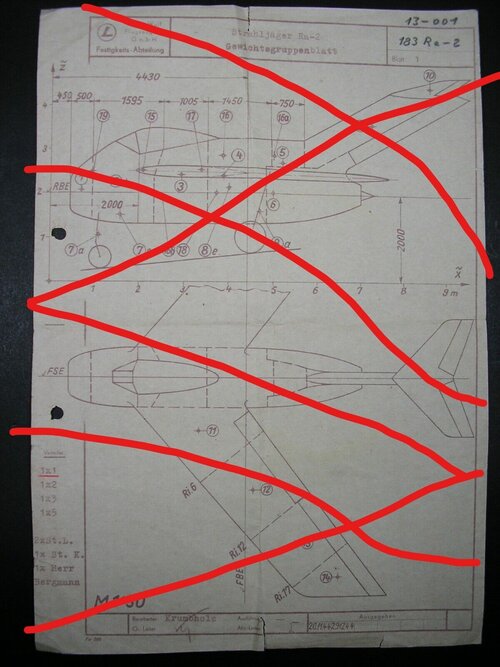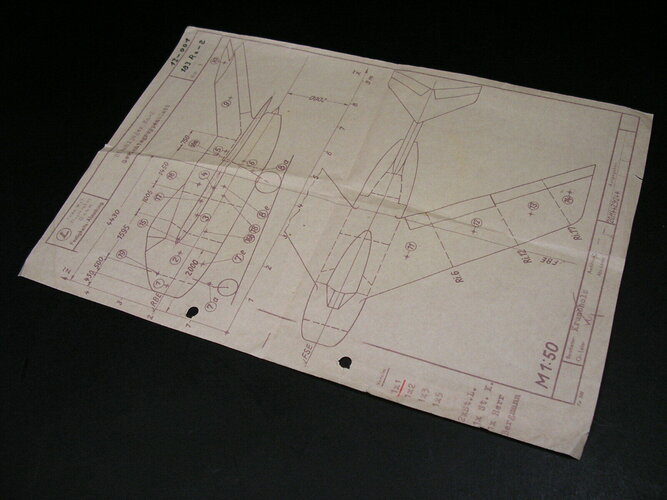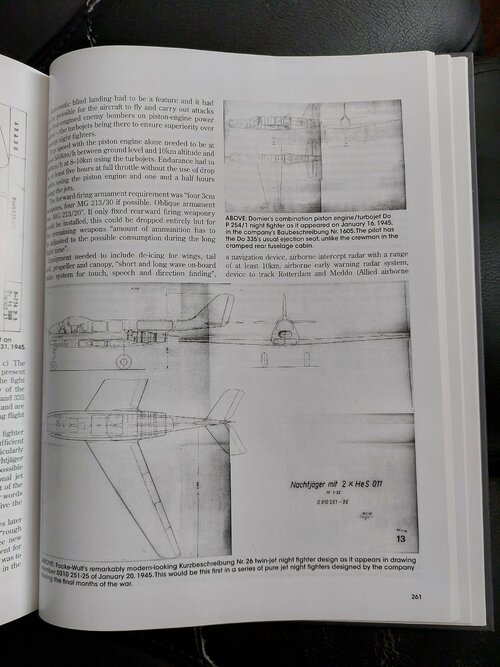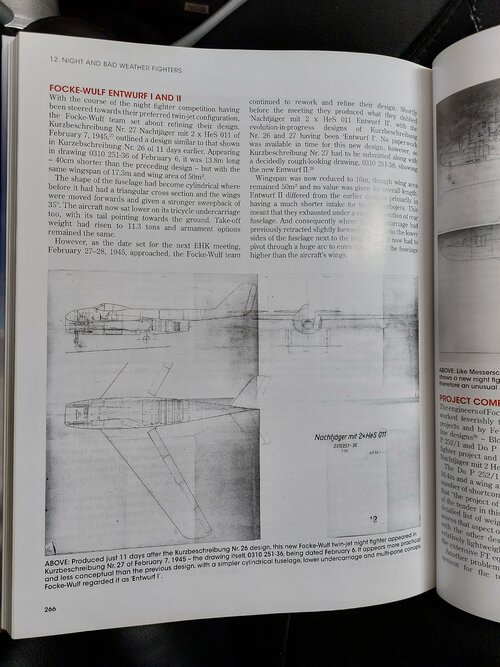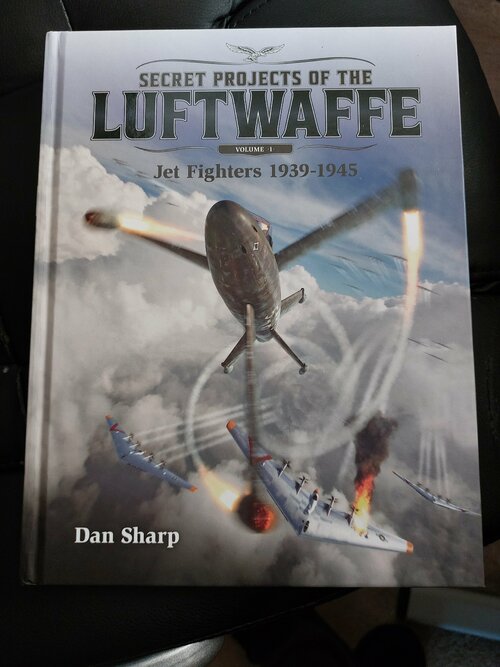You are using an out of date browser. It may not display this or other websites correctly.
You should upgrade or use an alternative browser.
You should upgrade or use an alternative browser.
Focke-Wulf jet fighter
- Thread starter Flitzer
- Start date
Zizi6785
ACCESS: Secret
- Joined
- 20 December 2006
- Messages
- 356
- Reaction score
- 267
I opened the book! 
This is an alternative variant of the twin boom FW Entwurf 4!
(But there is a mistake in my book, bottom of this picture the 3-view as the same as the first variant of this projekt. If someone has a right drawing, please send it to me.)
This is an alternative variant of the twin boom FW Entwurf 4!
(But there is a mistake in my book, bottom of this picture the 3-view as the same as the first variant of this projekt. If someone has a right drawing, please send it to me.)
- Joined
- 26 May 2006
- Messages
- 32,696
- Reaction score
- 11,963
From my files;
this was a classified report about Ta.183 in USSR,tells us that; this design completed and flying with Soviet Air Force emblem,
and all that happened during 1945 up to 1947,need confirm.
The source for picture only (not the Info).
https://forum.warthunder.com/index.php?/topic/319091-focke-wulf-ta-183-huckebein/
this was a classified report about Ta.183 in USSR,tells us that; this design completed and flying with Soviet Air Force emblem,
and all that happened during 1945 up to 1947,need confirm.
The source for picture only (not the Info).
https://forum.warthunder.com/index.php?/topic/319091-focke-wulf-ta-183-huckebein/
Attachments
- Joined
- 26 May 2006
- Messages
- 32,696
- Reaction score
- 11,963
Jemiba said:AFAIK all "photos" of the Ta 183 are just fakes and the mentioned site is about war gaming.
BTW, the folder of the source given in that site already is labelled "whif" ... :
OK for the Photo my dear Jemiba,it's fake,but about the report ?.
- Joined
- 11 March 2006
- Messages
- 8,610
- Reaction score
- 3,072
hesham, I think, you've read the post by Johnbr ?
http://www.secretprojects.co.uk/forum/index.php/topic,9086.msg290343.html#msg290343
"..... There is no concretic evidence, but there are rumors ...........There are also rumors ..."
From https://en.wikipedia.org/wiki/Rumor:
"... In the social sciences, a rumor involves some kind of a statement whose veracity is not quickly or ever confirmed. In addition, some scholars have identified rumor as a subset of propaganda. ....
...Rumors are also often discussed with regard to "misinformation" and "disinformation" (the former often seen as simply false and the latter seen as deliberately false, ..."
Maybe one day, in an old Russian shed, neglected and forgotten since decades, the remains of a Ta 183 in Russian
marking will be found. But until then, we should avoid such statements, especially if the source itself mentions severe doubts.
http://www.secretprojects.co.uk/forum/index.php/topic,9086.msg290343.html#msg290343
"..... There is no concretic evidence, but there are rumors ...........There are also rumors ..."
From https://en.wikipedia.org/wiki/Rumor:
"... In the social sciences, a rumor involves some kind of a statement whose veracity is not quickly or ever confirmed. In addition, some scholars have identified rumor as a subset of propaganda. ....
...Rumors are also often discussed with regard to "misinformation" and "disinformation" (the former often seen as simply false and the latter seen as deliberately false, ..."
Maybe one day, in an old Russian shed, neglected and forgotten since decades, the remains of a Ta 183 in Russian
marking will be found. But until then, we should avoid such statements, especially if the source itself mentions severe doubts.
Airborne2001
ACCESS: Confidential
- Joined
- 19 June 2020
- Messages
- 135
- Reaction score
- 126
The only place I see the Fw-252 get heavily featured is in World of War Planes (WoWP):

However, WoWP has created fake modifications of aircraft in the past to fill tech tree gaps. I have doubts about an "Fw-252" designation existing for an evolved version of the Ta-183.
If it is not a theoretical modification of the Ta-183 Design III, then it could be based off of the Focke-Wulf Super TL:

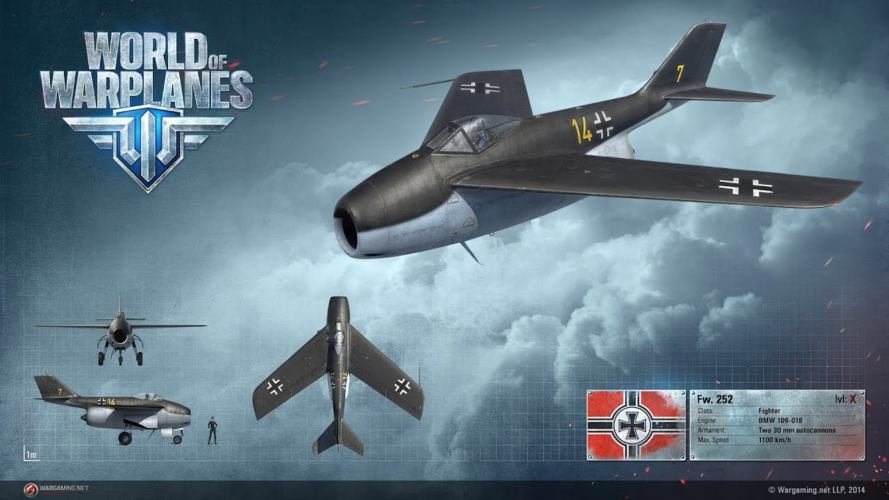
However, WoWP has created fake modifications of aircraft in the past to fill tech tree gaps. I have doubts about an "Fw-252" designation existing for an evolved version of the Ta-183.
If it is not a theoretical modification of the Ta-183 Design III, then it could be based off of the Focke-Wulf Super TL:
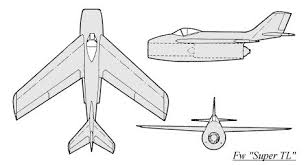
Last edited:
Focke-Wulf 1-TL Höhenjagdflugzeug mit BMW 018 (Super TL)
Except for the Heinkel A.G. and Junkers A.G, the German manufacturers of aircraft engines lacked the necessary infrastructure to build airframes. However, there is information of that time about projects of airplanes designed by BMW and Daimler Benz. They mainly are simple ideas to promote some of their less demanded products.
From 1943 it was evident that Germany did not have the required resources to manufacture big fleets of strategic bombers. Therefore, the projected heavy engines, that the designers of fighters tended to ignore, should adapt or die.
The BMW company had developed the powerful turbojet BMW 109-018, a monster with 4.95 m of length, 1.25 m of diameter and 3,400 kp static thrust, to power the Strahlbomber Projekt II, a flying wing able to fly at 985 km/h with 5,000 kg of bombs, a luxury that Germany could not afford. When Projekt II was cancelled by the end of 1944, there were not many projects of airplanes under study that wold have been able to house such a huge engine.
The firm Blohm und Voss designed a 125 per cent scaled-up version of the P.202 fighter, named P.198. It was a high-altitude interceptor with a BMW 018 suspended under the fuselage.
In November 1944 the EZS design team of BMW, led by Dipl. Ing. Huber, proposed a 65% scaled-down version of the Strahlbomber Projekt II powered by a single BMW 018. It was a flying wing of 23 m span able to fly at 1,040 km/h carrying heavy armament, able to destroy a B-29 with a single shoot of its four 55 mm cannons. It was a design with huge potential that was known as TL BMW Strahljäger Projekt V.
The solution chosen by the Bad Eilsen design team, under the leadership of the Dipl.-Ing. Von Halem, consisted in increasing by 115 per cent the dimensions of the Ta 183 B, replacing the He S 011A turbojet by a BMW 109-018. The new engine used the same type of fuel J2 as the BMW 003 but had a specific fuel consumption of only 1.10 and a much higher power/weight ratio.
The Focke-Wulf project, described in the Baubeschreibung Nr. 252 dossier in October 1944 and frequently cited in the specialized literature as Focke-Wulf Super TL, was a high-altitude interceptor far superior to Huckebein but did not surpass the design phase, with the BMW 109-018 being cancelled in December 1944.
Technical data
Wings: built of wood/plywood/steel, with 42 degrees rear swept and 12 per cent thickness, housing twelve fuel tanks, ailerons and flaps.
Tail surfaces: made of light alloy
Fuselage: Egg section, built with light alloy, housing the pressurised and armoured cockpit with ejector seat, three fuel tanks, two heavy cannons and the turbojet.
Landing gear: The main legs were retractable forward and the wheels were housed to both sides of the air duct. The nose leg was retractable backward after rotating 90 degrees.
Engine: one BMW 109-018 turbojet with 3400 kp static thrust.
Armament: Two Mk 108/30 heavy cannons and the possibility to transport different combinations of R4M rockets, 300 litres droppable fuel tanks, X-4 missiles or one SC/SD 500 bomb under the fuselage.
Take-off weight: 5,600 kg.
Estimated maximum speed: Mach 0.98
Estimated service ceiling: 13,000 m.
Wingspan: 11 m; Length: 10.87 m; Height: 4.75 m; Wing area: 25 sq. m.
Attachments
Airborne2001
ACCESS: Confidential
- Joined
- 19 June 2020
- Messages
- 135
- Reaction score
- 126
So perhaps that Fw-252 then is therefore rooted in a real design. The "Fw-252" therefore must come from Nr. 252 dossier number that you mentioned. Thank you for the information.Focke-Wulf 1-TL Höhenjagdflugzeug mit BMW 018 (Super TL)
Except for the Heinkel A.G. and Junkers A.G, the German manufacturers of aircraft engines lacked the necessary infrastructure to build airframes. However, there is information of that time about projects of airplanes designed by BMW and Daimler Benz. They mainly are simple ideas to promote some of their less demanded products.
From 1943 it was evident that Germany did not have the required resources to manufacture big fleets of strategic bombers. Therefore, the projected heavy engines, that the designers of fighters tended to ignore, should adapt or die.
The BMW company had developed the powerful turbojet BMW 109-018, a monster with 4.95 m of length, 1.25 m of diameter and 3,400 kp static thrust, to power the Strahlbomber Projekt II, a flying wing able to fly at 985 km/h with 5,000 kg of bombs, a luxury that Germany could not afford. When Projekt II was cancelled by the end of 1944, there were not many projects of airplanes under study that wold have been able to house such a huge engine.
The firm Blohm und Voss designed a 125 per cent scaled-up version of the P.202 fighter, named P.198. It was a high-altitude interceptor with a BMW 018 suspended under the fuselage.
In November 1944 the EZS design team of BMW, led by Dipl. Ing. Huber, proposed a 65% scaled-down version of the Strahlbomber Projekt II powered by a single BMW 018. It was a flying wing of 23 m span able to fly at 1,040 km/h carrying heavy armament, able to destroy a B-29 with a single shoot of its four 55 mm cannons. It was a design with huge potential that was known as TL BMW Strahljäger Projekt V.
The solution chosen by the Bad Eilsen design team, under the leadership of the Dipl.-Ing. Von Halem, consisted in increasing by 115 per cent the dimensions of the Ta 183 B, replacing the He S 011A turbojet by a BMW 109-018. The new engine used the same type of fuel J2 as the BMW 003 but had a specific fuel consumption of only 1.10 and a much higher power/weight ratio.
The Focke-Wulf project, described in the Baubeschreibung Nr. 252 dossier in October 1944 and frequently cited in the specialized literature as Focke-Wulf Super TL, was a high-altitude interceptor far superior to Huckebein but did not surpass the design phase, with the BMW 109-018 being cancelled in December 1944.
Technical data
Wings: built of wood/plywood/steel, with 42 degrees rear swept and 12 per cent thickness, housing twelve fuel tanks, ailerons and flaps.
Tail surfaces: made of light alloy
Fuselage: Egg section, built with light alloy, housing the pressurised and armoured cockpit with ejector seat, three fuel tanks, two heavy cannons and the turbojet.
Landing gear: The main legs were retractable forward and the wheels were housed to both sides of the air duct. The nose leg was retractable backward after rotating 90 degrees.
Engine: one BMW 109-018 turbojet with 3400 kp static thrust.
Armament: Two Mk 108/30 heavy cannons and the possibility to transport different combinations of R4M rockets, 300 litres droppable fuel tanks, X-4 missiles or one SC/SD 500 bomb under the fuselage.
Take-off weight: 5,600 kg.
Estimated maximum speed: Mach 0.98
Estimated service ceiling: 13,000 m.
Wingspan: 11 m; Length: 10.87 m; Height: 4.75 m; Wing area: 25 sq. m.
Vahe Demirjian
I really should change my personal text
- Joined
- 28 February 2013
- Messages
- 815
- Reaction score
- 539
I suppose you mean to emphasize that "Fw 252" was an invention by aviation historians stemming from the digits 252 in the Focke Wulf project drawing number 03 10 252.So perhaps that Fw-252 then is therefore rooted in a real design. The "Fw-252" therefore must come from Nr. 252 dossier number that you mentioned. Thank you for the information.Focke-Wulf 1-TL Höhenjagdflugzeug mit BMW 018 (Super TL)
Except for the Heinkel A.G. and Junkers A.G, the German manufacturers of aircraft engines lacked the necessary infrastructure to build airframes. However, there is information of that time about projects of airplanes designed by BMW and Daimler Benz. They mainly are simple ideas to promote some of their less demanded products.
From 1943 it was evident that Germany did not have the required resources to manufacture big fleets of strategic bombers. Therefore, the projected heavy engines, that the designers of fighters tended to ignore, should adapt or die.
The BMW company had developed the powerful turbojet BMW 109-018, a monster with 4.95 m of length, 1.25 m of diameter and 3,400 kp static thrust, to power the Strahlbomber Projekt II, a flying wing able to fly at 985 km/h with 5,000 kg of bombs, a luxury that Germany could not afford. When Projekt II was cancelled by the end of 1944, there were not many projects of airplanes under study that wold have been able to house such a huge engine.
The firm Blohm und Voss designed a 125 per cent scaled-up version of the P.202 fighter, named P.198. It was a high-altitude interceptor with a BMW 018 suspended under the fuselage.
In November 1944 the EZS design team of BMW, led by Dipl. Ing. Huber, proposed a 65% scaled-down version of the Strahlbomber Projekt II powered by a single BMW 018. It was a flying wing of 23 m span able to fly at 1,040 km/h carrying heavy armament, able to destroy a B-29 with a single shoot of its four 55 mm cannons. It was a design with huge potential that was known as TL BMW Strahljäger Projekt V.
The solution chosen by the Bad Eilsen design team, under the leadership of the Dipl.-Ing. Von Halem, consisted in increasing by 115 per cent the dimensions of the Ta 183 B, replacing the He S 011A turbojet by a BMW 109-018. The new engine used the same type of fuel J2 as the BMW 003 but had a specific fuel consumption of only 1.10 and a much higher power/weight ratio.
The Focke-Wulf project, described in the Baubeschreibung Nr. 252 dossier in October 1944 and frequently cited in the specialized literature as Focke-Wulf Super TL, was a high-altitude interceptor far superior to Huckebein but did not surpass the design phase, with the BMW 109-018 being cancelled in December 1944.
Technical data
Wings: built of wood/plywood/steel, with 42 degrees rear swept and 12 per cent thickness, housing twelve fuel tanks, ailerons and flaps.
Tail surfaces: made of light alloy
Fuselage: Egg section, built with light alloy, housing the pressurised and armoured cockpit with ejector seat, three fuel tanks, two heavy cannons and the turbojet.
Landing gear: The main legs were retractable forward and the wheels were housed to both sides of the air duct. The nose leg was retractable backward after rotating 90 degrees.
Engine: one BMW 109-018 turbojet with 3400 kp static thrust.
Armament: Two Mk 108/30 heavy cannons and the possibility to transport different combinations of R4M rockets, 300 litres droppable fuel tanks, X-4 missiles or one SC/SD 500 bomb under the fuselage.
Take-off weight: 5,600 kg.
Estimated maximum speed: Mach 0.98
Estimated service ceiling: 13,000 m.
Wingspan: 11 m; Length: 10.87 m; Height: 4.75 m; Wing area: 25 sq. m.
- Joined
- 11 June 2014
- Messages
- 1,334
- Reaction score
- 1,784
I thought Justo's contribution to this discussion was worthy of a more detailed response as follows in bold:
Focke-Wulf 1-TL Höhenjagdflugzeug mit BMW 018 (Super TL)
Except for the Heinkel A.G. and Junkers A.G, the German manufacturers of aircraft engines lacked the necessary infrastructure to build airframes. However, there is information of that time about projects of airplanes designed by BMW and Daimler Benz. They mainly are simple ideas to promote some of their less demanded products.
True. Although the Strahlbombers mentioned below were actually designed by Heinkel on BMW's instructions. How much actual involvement BMW had in those designs is unclear. In the same way, Focke-Wulf was hired by Daimler-Benz to create detailed drawings of its jet bomber design.
The BMW company had developed the powerful turbojet BMW 109-018, a monster with 4.95 m of length, 1.25 m of diameter and 3,400 kp static thrust, to power the Strahlbomber Projekt II, a flying wing able to fly at 985 km/h with 5,000 kg of bombs, a luxury that Germany could not afford. When Projekt II was cancelled by the end of 1944, there were not many projects of airplanes under study that wold have been able to house such a huge engine.
According to BMW's Vorlaeufige Einbaumappe fuer Triebwerk BMW-018 of August 10, 1944, the 018 was 5000mm long with, as you say, a maximum diameter of 1250mm. The two BMW Strahlbomber designs of EZS - Bericht Nr. 47 EZV Nr. 537/44 (report pages dated May 25, 1944, appended drawings dated June 2, 1944) were never approved for development so I don't think it's entirely accurate to say that they were cancelled or to give a vague date for when that is supposed to have happened.
The firm Blohm und Voss designed a 125 per cent scaled-up version of the P.202 fighter, named P.198. It was a high-altitude interceptor with a BMW 018 suspended under the fuselage.
Blohm & Voss's project numbering was chronological throughout, so P 198 came first, then P 202. I suppose the P 202 could have been a downscaled version of the P 198, I don't know - but they look quite different to me.
In November 1944 the EZS design team of BMW, led by Dipl. Ing. Huber, proposed a 65% scaled-down version of the Strahlbomber Projekt II powered by a single BMW 018. It was a flying wing of 23 m span able to fly at 1,040 km/h carrying heavy armament, able to destroy a B-29 with a single shoot of its four 55 mm cannons. It was a design with huge potential that was known as TL BMW Strahljäger Projekt V.
I don't know of any evidence for this but you could be right. What's your source?
The solution chosen by the Bad Eilsen design team, under the leadership of the Dipl.-Ing. Von Halem, consisted in increasing by 115 per cent the dimensions of the Ta 183 B, replacing the He S 011A turbojet by a BMW 109-018. The new engine used the same type of fuel J2 as the BMW 003 but had a specific fuel consumption of only 1.10 and a much higher power/weight ratio.
While von Halem worked for Focke-Wulf, there is no evidence that he was a team leader or even a senior member of staff. Company organisation charts from February 15, 1945, do not mention him. Focke-Wulf had a main project office under Chef-Ing. Ludwig Mittelhuber and two experimental design offices known as 'Flugmechanik E' and 'Flugmechanik L'. 'E' was led by Chef-Ing. Gotthold Mathias and 'L' was led by Obering. Herbert Wolff. Little is really known about von Halem but there is circumstantial evidence that he actually worked under Obering. Dr Otto Pabst at Focke-Wulf's Gas-dynamik Abteilung, which was based at Kirchhorsten, about 8km north of Bad Eilsen, making it a satellite of the main factory complex. It appears that von Halem was tasked with creating airframe designs to suit the ramjets Pabst was working on. Certainly, there is a sketch with von Halem's name on it which shows a 'Super TL' but there is no suggestion that this design has any importance or that the 'Super TL' in question was actually a BMW 018. The main project office under Mittelhuber had come up with a fighter design powered by a single BMW 018 which I will describe below. And spoilers - it would have looked nothing like von Halem's 'Super TL'.
The Focke-Wulf project, described in the Baubeschreibung Nr. 252 dossier in October 1944 and frequently cited in the specialized literature as Focke-Wulf Super TL, was a high-altitude interceptor far superior to Huckebein but did not surpass the design phase, with the BMW 109-018 being cancelled in December 1944.
Focke-Wulf Baubeschreibung Nr. 252 was entitled 'Höhenjagdflugzeug Fw 190 DB 603 A'. The company's Baubeschreibung reports were numbered chronologically and although I don't have a copy of Nr. 252, Nr. 249 concerned a Grosstransporter design and was dated June 8, 1942. The next nearest one I can lay my hands on is Nr. 256 Nachtjaeger Ta 154. That's dated December 20, 1942. Nr. 252 would mostly likely have been produced towards the end of 1942. It had nothing to do with the BMW 018.
As to the '252' number, Vahe Demirjian is correct that there was indeed a Focke-Wulf drawing sequence which included 252. However, only two drawings from this series are known: 0310 252-102 and 0310 252-112. Both of these are included in Focke-Wulf Kurzbeschreibung Nr. 23 Zweimotoriges TL-Jagdflugzeug mit HeS-011. There is no evidence that the '252' drawing series included depictions of Focke-Wulf's BMW 018-powered fighter design. Although, if you squint a bit, the fighter powered by two HeS 011s shown in those drawings does look vaguely like von Halem's 'Super TL'.
Technical data
Wings: built of wood/plywood/steel, with 42 degrees rear swept and 12 per cent thickness, housing twelve fuel tanks, ailerons and flaps.
Tail surfaces: made of light alloy
Fuselage: Egg section, built with light alloy, housing the pressurised and armoured cockpit with ejector seat, three fuel tanks, two heavy cannons and the turbojet.
Landing gear: The main legs were retractable forward and the wheels were housed to both sides of the air duct. The nose leg was retractable backward after rotating 90 degrees.
Engine: one BMW 109-018 turbojet with 3400 kp static thrust.
Armament: Two Mk 108/30 heavy cannons and the possibility to transport different combinations of R4M rockets, 300 litres droppable fuel tanks, X-4 missiles or one SC/SD 500 bomb under the fuselage.
Take-off weight: 5,600 kg.
Estimated maximum speed: Mach 0.98
Estimated service ceiling: 13,000 m.
Wingspan: 11 m; Length: 10.87 m; Height: 4.75 m; Wing area: 25 sq. m.
Fock-Wulf's data sheet for its BMW 018-powered fighter - the only known document providing visual evidence of this enigmatic design - is entitled 'Spezialhoehenjaeger mit BMW 109-018' and dated August 30, 1944. The aircraft is described as having a single engine, low wing, twin-rudder and nosewheel layout. Its intended service ceiling was 16km (the BMW 018 was always intended to be a turbojet specially adapted for high-altitude performance - that was its only purpose). Take-off weight is listed as 8700kg. Wing area is 51sq m, wingspan is 15m, length is 14.2m, height is 4.4m. It is a single-seater with a pressure cabin.
The nosewheel is 630 x 220mm and the mainwheels are 1015 x 380mm. The wing has a 31-degree sweepback. 1700kg of fuel is carried for the single BMW 018. There are three weapons options:
1) 4 x MG 213 with 800 rounds or
2) 2 x MG 213 with 400 rounds and 2 x MK 103 with 180 rounds
3) 4 x MK 108 with 260 rounds
Performance is given as 910km/h at sea level, 960km/h (I think - the text is a little blurry here) at 6km altitude, 920km/h at 14km and 900km/h at 16km. Climb rate is 33m/sec at sea level, dwindling to 2m/sec at 16km.
So Focke-Wulf was working on its BMW 018 design earlier than you suggest - in August 1944. The design was for a much larger aircraft too - bigger in every dimension except height. You mention X-4 missiles but there is no evidence that X-4s were being specified for any fighters at this time. Similarly, this was a high-altitude fighter - the 018 was a high-altitude engine - why would it be specified with a bomb load? There is no evidence for that. I think it is a massive leap to take a wonky sketch thought to have been produced by a designer who wasn't a member of any of Focke-Wulf's main fighter design team, let alone a leader of one, and turn it into a fully fledged fighter fitted with X-4s and bombs. Furthermore, there is evidence from GL meetings that work on BMW 018-powered fighters was suspended prior to the advent of the Volksjaeger in September 1944 because the 018 was not due to be ready before 1946. It therefore made little sense to continue working on it when the HeS 011, at least, would be delivered in 1945.
Finally, there was no Fw 252. There was already a Junkers Ju 252 and it had only been introduced in 1943 - a year earlier.
Focke-Wulf 1-TL Höhenjagdflugzeug mit BMW 018 (Super TL)
Except for the Heinkel A.G. and Junkers A.G, the German manufacturers of aircraft engines lacked the necessary infrastructure to build airframes. However, there is information of that time about projects of airplanes designed by BMW and Daimler Benz. They mainly are simple ideas to promote some of their less demanded products.
True. Although the Strahlbombers mentioned below were actually designed by Heinkel on BMW's instructions. How much actual involvement BMW had in those designs is unclear. In the same way, Focke-Wulf was hired by Daimler-Benz to create detailed drawings of its jet bomber design.
The BMW company had developed the powerful turbojet BMW 109-018, a monster with 4.95 m of length, 1.25 m of diameter and 3,400 kp static thrust, to power the Strahlbomber Projekt II, a flying wing able to fly at 985 km/h with 5,000 kg of bombs, a luxury that Germany could not afford. When Projekt II was cancelled by the end of 1944, there were not many projects of airplanes under study that wold have been able to house such a huge engine.
According to BMW's Vorlaeufige Einbaumappe fuer Triebwerk BMW-018 of August 10, 1944, the 018 was 5000mm long with, as you say, a maximum diameter of 1250mm. The two BMW Strahlbomber designs of EZS - Bericht Nr. 47 EZV Nr. 537/44 (report pages dated May 25, 1944, appended drawings dated June 2, 1944) were never approved for development so I don't think it's entirely accurate to say that they were cancelled or to give a vague date for when that is supposed to have happened.
The firm Blohm und Voss designed a 125 per cent scaled-up version of the P.202 fighter, named P.198. It was a high-altitude interceptor with a BMW 018 suspended under the fuselage.
Blohm & Voss's project numbering was chronological throughout, so P 198 came first, then P 202. I suppose the P 202 could have been a downscaled version of the P 198, I don't know - but they look quite different to me.
In November 1944 the EZS design team of BMW, led by Dipl. Ing. Huber, proposed a 65% scaled-down version of the Strahlbomber Projekt II powered by a single BMW 018. It was a flying wing of 23 m span able to fly at 1,040 km/h carrying heavy armament, able to destroy a B-29 with a single shoot of its four 55 mm cannons. It was a design with huge potential that was known as TL BMW Strahljäger Projekt V.
I don't know of any evidence for this but you could be right. What's your source?
The solution chosen by the Bad Eilsen design team, under the leadership of the Dipl.-Ing. Von Halem, consisted in increasing by 115 per cent the dimensions of the Ta 183 B, replacing the He S 011A turbojet by a BMW 109-018. The new engine used the same type of fuel J2 as the BMW 003 but had a specific fuel consumption of only 1.10 and a much higher power/weight ratio.
While von Halem worked for Focke-Wulf, there is no evidence that he was a team leader or even a senior member of staff. Company organisation charts from February 15, 1945, do not mention him. Focke-Wulf had a main project office under Chef-Ing. Ludwig Mittelhuber and two experimental design offices known as 'Flugmechanik E' and 'Flugmechanik L'. 'E' was led by Chef-Ing. Gotthold Mathias and 'L' was led by Obering. Herbert Wolff. Little is really known about von Halem but there is circumstantial evidence that he actually worked under Obering. Dr Otto Pabst at Focke-Wulf's Gas-dynamik Abteilung, which was based at Kirchhorsten, about 8km north of Bad Eilsen, making it a satellite of the main factory complex. It appears that von Halem was tasked with creating airframe designs to suit the ramjets Pabst was working on. Certainly, there is a sketch with von Halem's name on it which shows a 'Super TL' but there is no suggestion that this design has any importance or that the 'Super TL' in question was actually a BMW 018. The main project office under Mittelhuber had come up with a fighter design powered by a single BMW 018 which I will describe below. And spoilers - it would have looked nothing like von Halem's 'Super TL'.
The Focke-Wulf project, described in the Baubeschreibung Nr. 252 dossier in October 1944 and frequently cited in the specialized literature as Focke-Wulf Super TL, was a high-altitude interceptor far superior to Huckebein but did not surpass the design phase, with the BMW 109-018 being cancelled in December 1944.
Focke-Wulf Baubeschreibung Nr. 252 was entitled 'Höhenjagdflugzeug Fw 190 DB 603 A'. The company's Baubeschreibung reports were numbered chronologically and although I don't have a copy of Nr. 252, Nr. 249 concerned a Grosstransporter design and was dated June 8, 1942. The next nearest one I can lay my hands on is Nr. 256 Nachtjaeger Ta 154. That's dated December 20, 1942. Nr. 252 would mostly likely have been produced towards the end of 1942. It had nothing to do with the BMW 018.
As to the '252' number, Vahe Demirjian is correct that there was indeed a Focke-Wulf drawing sequence which included 252. However, only two drawings from this series are known: 0310 252-102 and 0310 252-112. Both of these are included in Focke-Wulf Kurzbeschreibung Nr. 23 Zweimotoriges TL-Jagdflugzeug mit HeS-011. There is no evidence that the '252' drawing series included depictions of Focke-Wulf's BMW 018-powered fighter design. Although, if you squint a bit, the fighter powered by two HeS 011s shown in those drawings does look vaguely like von Halem's 'Super TL'.
Technical data
Wings: built of wood/plywood/steel, with 42 degrees rear swept and 12 per cent thickness, housing twelve fuel tanks, ailerons and flaps.
Tail surfaces: made of light alloy
Fuselage: Egg section, built with light alloy, housing the pressurised and armoured cockpit with ejector seat, three fuel tanks, two heavy cannons and the turbojet.
Landing gear: The main legs were retractable forward and the wheels were housed to both sides of the air duct. The nose leg was retractable backward after rotating 90 degrees.
Engine: one BMW 109-018 turbojet with 3400 kp static thrust.
Armament: Two Mk 108/30 heavy cannons and the possibility to transport different combinations of R4M rockets, 300 litres droppable fuel tanks, X-4 missiles or one SC/SD 500 bomb under the fuselage.
Take-off weight: 5,600 kg.
Estimated maximum speed: Mach 0.98
Estimated service ceiling: 13,000 m.
Wingspan: 11 m; Length: 10.87 m; Height: 4.75 m; Wing area: 25 sq. m.
Fock-Wulf's data sheet for its BMW 018-powered fighter - the only known document providing visual evidence of this enigmatic design - is entitled 'Spezialhoehenjaeger mit BMW 109-018' and dated August 30, 1944. The aircraft is described as having a single engine, low wing, twin-rudder and nosewheel layout. Its intended service ceiling was 16km (the BMW 018 was always intended to be a turbojet specially adapted for high-altitude performance - that was its only purpose). Take-off weight is listed as 8700kg. Wing area is 51sq m, wingspan is 15m, length is 14.2m, height is 4.4m. It is a single-seater with a pressure cabin.
The nosewheel is 630 x 220mm and the mainwheels are 1015 x 380mm. The wing has a 31-degree sweepback. 1700kg of fuel is carried for the single BMW 018. There are three weapons options:
1) 4 x MG 213 with 800 rounds or
2) 2 x MG 213 with 400 rounds and 2 x MK 103 with 180 rounds
3) 4 x MK 108 with 260 rounds
Performance is given as 910km/h at sea level, 960km/h (I think - the text is a little blurry here) at 6km altitude, 920km/h at 14km and 900km/h at 16km. Climb rate is 33m/sec at sea level, dwindling to 2m/sec at 16km.
So Focke-Wulf was working on its BMW 018 design earlier than you suggest - in August 1944. The design was for a much larger aircraft too - bigger in every dimension except height. You mention X-4 missiles but there is no evidence that X-4s were being specified for any fighters at this time. Similarly, this was a high-altitude fighter - the 018 was a high-altitude engine - why would it be specified with a bomb load? There is no evidence for that. I think it is a massive leap to take a wonky sketch thought to have been produced by a designer who wasn't a member of any of Focke-Wulf's main fighter design team, let alone a leader of one, and turn it into a fully fledged fighter fitted with X-4s and bombs. Furthermore, there is evidence from GL meetings that work on BMW 018-powered fighters was suspended prior to the advent of the Volksjaeger in September 1944 because the 018 was not due to be ready before 1946. It therefore made little sense to continue working on it when the HeS 011, at least, would be delivered in 1945.
Finally, there was no Fw 252. There was already a Junkers Ju 252 and it had only been introduced in 1943 - a year earlier.
Last edited:
Airborne2001
ACCESS: Confidential
- Joined
- 19 June 2020
- Messages
- 135
- Reaction score
- 126
Correct.I suppose you mean to emphasize that "Fw 252" was an invention by aviation historians stemming from the digits 252 in the Focke Wulf project drawing number 03 10 252.So perhaps that Fw-252 then is therefore rooted in a real design. The "Fw-252" therefore must come from Nr. 252 dossier number that you mentioned. Thank you for the information.Focke-Wulf 1-TL Höhenjagdflugzeug mit BMW 018 (Super TL)
Except for the Heinkel A.G. and Junkers A.G, the German manufacturers of aircraft engines lacked the necessary infrastructure to build airframes. However, there is information of that time about projects of airplanes designed by BMW and Daimler Benz. They mainly are simple ideas to promote some of their less demanded products.
From 1943 it was evident that Germany did not have the required resources to manufacture big fleets of strategic bombers. Therefore, the projected heavy engines, that the designers of fighters tended to ignore, should adapt or die.
The BMW company had developed the powerful turbojet BMW 109-018, a monster with 4.95 m of length, 1.25 m of diameter and 3,400 kp static thrust, to power the Strahlbomber Projekt II, a flying wing able to fly at 985 km/h with 5,000 kg of bombs, a luxury that Germany could not afford. When Projekt II was cancelled by the end of 1944, there were not many projects of airplanes under study that wold have been able to house such a huge engine.
The firm Blohm und Voss designed a 125 per cent scaled-up version of the P.202 fighter, named P.198. It was a high-altitude interceptor with a BMW 018 suspended under the fuselage.
In November 1944 the EZS design team of BMW, led by Dipl. Ing. Huber, proposed a 65% scaled-down version of the Strahlbomber Projekt II powered by a single BMW 018. It was a flying wing of 23 m span able to fly at 1,040 km/h carrying heavy armament, able to destroy a B-29 with a single shoot of its four 55 mm cannons. It was a design with huge potential that was known as TL BMW Strahljäger Projekt V.
The solution chosen by the Bad Eilsen design team, under the leadership of the Dipl.-Ing. Von Halem, consisted in increasing by 115 per cent the dimensions of the Ta 183 B, replacing the He S 011A turbojet by a BMW 109-018. The new engine used the same type of fuel J2 as the BMW 003 but had a specific fuel consumption of only 1.10 and a much higher power/weight ratio.
The Focke-Wulf project, described in the Baubeschreibung Nr. 252 dossier in October 1944 and frequently cited in the specialized literature as Focke-Wulf Super TL, was a high-altitude interceptor far superior to Huckebein but did not surpass the design phase, with the BMW 109-018 being cancelled in December 1944.
Technical data
Wings: built of wood/plywood/steel, with 42 degrees rear swept and 12 per cent thickness, housing twelve fuel tanks, ailerons and flaps.
Tail surfaces: made of light alloy
Fuselage: Egg section, built with light alloy, housing the pressurised and armoured cockpit with ejector seat, three fuel tanks, two heavy cannons and the turbojet.
Landing gear: The main legs were retractable forward and the wheels were housed to both sides of the air duct. The nose leg was retractable backward after rotating 90 degrees.
Engine: one BMW 109-018 turbojet with 3400 kp static thrust.
Armament: Two Mk 108/30 heavy cannons and the possibility to transport different combinations of R4M rockets, 300 litres droppable fuel tanks, X-4 missiles or one SC/SD 500 bomb under the fuselage.
Take-off weight: 5,600 kg.
Estimated maximum speed: Mach 0.98
Estimated service ceiling: 13,000 m.
Wingspan: 11 m; Length: 10.87 m; Height: 4.75 m; Wing area: 25 sq. m.
Airborne2001
ACCESS: Confidential
- Joined
- 19 June 2020
- Messages
- 135
- Reaction score
- 126
Oh, interesting. I am surprised that I did not catch the Fw-252/Ju-252 similarity in designation . Do you have any sketches (or artistic interpretations) of what the larger design you referenced may have looked like?I thought Justo's contribution to this discussion was worthy of a more detailed response as follows in bold:
Focke-Wulf 1-TL Höhenjagdflugzeug mit BMW 018 (Super TL)
Except for the Heinkel A.G. and Junkers A.G, the German manufacturers of aircraft engines lacked the necessary infrastructure to build airframes. However, there is information of that time about projects of airplanes designed by BMW and Daimler Benz. They mainly are simple ideas to promote some of their less demanded products.
True. Although the Strahlbombers mentioned below were actually designed by Heinkel on BMW's instructions. How much actual involvement BMW had in those designs is unclear. In the same way, Focke-Wulf was hired by Daimler-Benz to create detailed drawings of its jet bomber design.
The BMW company had developed the powerful turbojet BMW 109-018, a monster with 4.95 m of length, 1.25 m of diameter and 3,400 kp static thrust, to power the Strahlbomber Projekt II, a flying wing able to fly at 985 km/h with 5,000 kg of bombs, a luxury that Germany could not afford. When Projekt II was cancelled by the end of 1944, there were not many projects of airplanes under study that wold have been able to house such a huge engine.
According to BMW's Vorlaeufige Einbaumappe fuer Triebwerk BMW-018 of August 10, 1944, the 018 was 5000mm long with, as you say, a maximum diameter of 1250mm. The two BMW Strahlbomber designs of EZS - Bericht Nr. 47 EZV Nr. 537/44 (report pages dated May 25, 1944, appended drawings dated June 2, 1944) were never approved for development so I don't think it's entirely accurate to say that they were cancelled or to give a vague date for when that is supposed to have happened.
The firm Blohm und Voss designed a 125 per cent scaled-up version of the P.202 fighter, named P.198. It was a high-altitude interceptor with a BMW 018 suspended under the fuselage.
Blohm & Voss's project numbering was chronological throughout, so P 198 came first, then P 202. I suppose the P 202 could have been a downscaled version of the P 198, I don't know - but they look quite different to me.
In November 1944 the EZS design team of BMW, led by Dipl. Ing. Huber, proposed a 65% scaled-down version of the Strahlbomber Projekt II powered by a single BMW 018. It was a flying wing of 23 m span able to fly at 1,040 km/h carrying heavy armament, able to destroy a B-29 with a single shoot of its four 55 mm cannons. It was a design with huge potential that was known as TL BMW Strahljäger Projekt V.
I don't know of any evidence for this but you could be right. What's your source?
The solution chosen by the Bad Eilsen design team, under the leadership of the Dipl.-Ing. Von Halem, consisted in increasing by 115 per cent the dimensions of the Ta 183 B, replacing the He S 011A turbojet by a BMW 109-018. The new engine used the same type of fuel J2 as the BMW 003 but had a specific fuel consumption of only 1.10 and a much higher power/weight ratio.
While von Halem worked for Focke-Wulf, there is no evidence that he was a team leader or even a senior member of staff. Company organisation charts from February 15, 1945, do not mention him. Focke-Wulf had a main project office under Chef-Ing. Ludwig Mittelhuber and two experimental design offices known as 'Flugmechanik E' and 'Flugmechanik L'. 'E' was led by Chef-Ing. Gotthold Mathias and 'L' was led by Obering. Herbert Wolff. Little is really known about von Halem but there is circumstantial evidence that he actually worked under Obering. Dr Otto Pabst at Focke-Wulf's Gas-dynamik Abteilung, which was based at Kirchhorsten, about 8km north of Bad Eilsen, making it a satellite of the main factory complex. It appears that von Halem was tasked with creating airframe designs to suit the ramjets Pabst was working on. Certainly, there is a sketch with von Halem's name on it which shows a 'Super TL' but there is no suggestion that this design has any importance or that the 'Super TL' in question was actually a BMW 018. The main project office under Mittelhuber had come up with a fighter design powered by a single BMW 018 which I will describe below. And spoilers - it would have looked nothing like von Halem's 'Super TL'.
The Focke-Wulf project, described in the Baubeschreibung Nr. 252 dossier in October 1944 and frequently cited in the specialized literature as Focke-Wulf Super TL, was a high-altitude interceptor far superior to Huckebein but did not surpass the design phase, with the BMW 109-018 being cancelled in December 1944.
Focke-Wulf Baubeschreibung Nr. 252 was entitled 'Höhenjagdflugzeug Fw 190 DB 603 A'. The company's Baubeschreibung reports were numbered chronologically and although I don't have a copy of Nr. 252, Nr. 249 concerned a Grosstransporter design and was dated June 8, 1942. The next nearest one I can lay my hands on is Nr. 256 Nachtjaeger Ta 154. That's dated December 20, 1942. Nr. 252 would mostly likely have been produced towards the end of 1942. It had nothing to do with the BMW 018.
As to the '252' number, Vahe Demirjian is correct that there was indeed a Focke-Wulf drawing sequence which included 252. However, only two drawings from this series are known: 0310 252-102 and 0310 252-112. Both of these are included in Focke-Wulf Kurzbeschreibung Nr. 23 Zweimotoriges TL-Jagdflugzeug mit HeS-011. There is no evidence that the '252' drawing series included depictions of Focke-Wulf's BMW 018-powered fighter design. Although, if you squint a bit, the fighter powered by two HeS 011s shown in those drawings does look vaguely like von Halem's 'Super TL'.
Technical data
Wings: built of wood/plywood/steel, with 42 degrees rear swept and 12 per cent thickness, housing twelve fuel tanks, ailerons and flaps.
Tail surfaces: made of light alloy
Fuselage: Egg section, built with light alloy, housing the pressurised and armoured cockpit with ejector seat, three fuel tanks, two heavy cannons and the turbojet.
Landing gear: The main legs were retractable forward and the wheels were housed to both sides of the air duct. The nose leg was retractable backward after rotating 90 degrees.
Engine: one BMW 109-018 turbojet with 3400 kp static thrust.
Armament: Two Mk 108/30 heavy cannons and the possibility to transport different combinations of R4M rockets, 300 litres droppable fuel tanks, X-4 missiles or one SC/SD 500 bomb under the fuselage.
Take-off weight: 5,600 kg.
Estimated maximum speed: Mach 0.98
Estimated service ceiling: 13,000 m.
Wingspan: 11 m; Length: 10.87 m; Height: 4.75 m; Wing area: 25 sq. m.
Fock-Wulf's data sheet for its BMW 018-powered fighter - the only known document providing visual evidence of this enigmatic design - is entitled 'Spezialhoehenjaeger mit BMW 109-018' and dated August 30, 1944. The aircraft is described as having a single engine, low wing, twin-rudder and nosewheel layout. Its intended service ceiling was 16km (the BMW 018 was always intended to be a turbojet specially adapted for high-altitude performance - that was its only purpose). Take-off weight is listed as 8700kg. Wing area is 51sq m, wingspan is 15m, length is 14.2m, height is 4.4m. It is a single-seater with a pressure cabin.
The nosewheel is 630 x 220mm and the mainwheels are 1015 x 380mm. The wing has a 31-degree sweepback. 1700kg of fuel is carried for the single BMW 018. There are three weapons options:
1) 4 x MG 213 with 800 rounds or
2) 2 x MG 213 with 400 rounds and 2 x MK 103 with 180 rounds
3) 4 x MK 108 with 260 rounds
Performance is given as 910km/h at sea level, 960km/h (I think - the text is a little blurry here) at 6km altitude, 920km/h at 14km and 900km/h at 16km. Climb rate is 33m/sec at sea level, dwindling to 2m/sec at 16km.
So Focke-Wulf was working on its BMW 018 design earlier than you suggest - in August 1944. The design was for a much larger aircraft too - bigger in every dimension except height. You mention X-4 missiles but there is no evidence that X-4s were being specified for any fighters at this time. Similarly, this was a high-altitude fighter - the 018 was a high-altitude engine - why would it be specified with a bomb load? There is no evidence for that. I think it is a massive leap to take a wonky sketch thought to have been produced by a designer who wasn't a member of any of Focke-Wulf's main fighter design team, let alone a leader of one, and turn it into a fully fledged fighter fitted with X-4s and bombs. Furthermore, there is evidence from GL meetings that work on BMW 018-powered fighters was suspended prior to the advent of the Volksjaeger in September 1944 because the 018 was not due to be ready before 1946. It therefore made little sense to continue working on it when the HeS 011, at least, would be delivered in 1945.
Finally, there was no Fw 252. There was already a Junkers Ju 252 and it had only been introduced in 1943 - a year earlier.
Form "Jet Planes of the Third Reich, The Secret Projects, Volume One, by Manfred Griehl, Monogram, 1988In November 1944 the EZS design team of BMW, led by Dipl. Ing. Huber, proposed a 65% scaled-down version of the Strahlbomber Projekt II powered by a single BMW 018. It was a flying wing of 23 m span able to fly at 1,040 km/h carrying heavy armament, able to destroy a B-29 with a single shoot of its four 55 mm cannons. It was a design with huge potential that was known as TL BMW Strahljäger Projekt V.
I don't know of any evidence for this but you could be right. What's your source?
Attachments
From. "German Aircraft, New and Projected Types" , A.I.2 (G) Report N0.2383, January 1946.The firm Blohm und Voss designed a 125 per cent scaled-up version of the P.202 fighter, named P.198. It was a high-altitude interceptor with a BMW 018 suspended under the fuselage.
Blohm & Voss's project numbering was chronological throughout, so P 198 came first, then P 202. I suppose the P 202 could have been a downscaled version of the P 198, I don't know - but they look quite different to me.
-Die Deutsch Luftrüstung 1933-1945, Band .1,Bernard & Graefe Verlag, 1993, Air International April 1975 and unknown source.
Attachments
From: "German Jet Engines and Gas Turbine Development 1930-1945" by Antony L. Kay, Airlife 2002.The BMW company had developed the powerful turbojet BMW 109-018, a monster with 4.95 m of length, 1.25 m of diameter and 3,400 kp static thrust, to power the Strahlbomber Projekt II, a flying wing able to fly at 985 km/h with 5,000 kg of bombs, a luxury that Germany could not afford. When Projekt II was cancelled by the end of 1944, there were not many projects of airplanes under study that wold have been able to house such a huge engine.
According to BMW's Vorlaeufige Einbaumappe fuer Triebwerk BMW-018 of August 10, 1944, the 018 was 5000mm long with, as you say, a maximum diameter of 1250mm. The two BMW Strahlbomber designs of EZS - Bericht Nr. 47 EZV Nr. 537/44 (report pages dated May 25, 1944, appended drawings dated June 2, 1944) were never approved for development so I don't think it's entirely accurate to say that they were cancelled or to give a vague date for when that is supposed to have happened.
Attachments
I agreeFinally, there was no Fw 252. There was already a Junkers Ju 252 and it had only been introduced in 1943 - a year earlier.
- Joined
- 11 June 2014
- Messages
- 1,334
- Reaction score
- 1,784
No. There is no known contemporary drawing of Focke-Wulf's Spezialhoehenjaeger mit BMW 018 - but I'm sure that one must have existed.Oh, interesting. I am surprised that I did not catch the Fw-252/Ju-252 similarity in designation . Do you have any sketches (or artistic interpretations) of what the larger design you referenced may have looked like?I thought Justo's contribution to this discussion was worthy of a more detailed response as follows in bold:
Last edited:
- Joined
- 11 June 2014
- Messages
- 1,334
- Reaction score
- 1,784
Form "Jet Planes of the Third Reich, The Secret Projects, Volume One, by Manfred Griehl, Monogram, 1988In November 1944 the EZS design team of BMW, led by Dipl. Ing. Huber, proposed a 65% scaled-down version of the Strahlbomber Projekt II powered by a single BMW 018. It was a flying wing of 23 m span able to fly at 1,040 km/h carrying heavy armament, able to destroy a B-29 with a single shoot of its four 55 mm cannons. It was a design with huge potential that was known as TL BMW Strahljäger Projekt V.
I don't know of any evidence for this but you could be right. What's your source?
I don't see any mention of the designation 'TL BMW Strahljaeger Projekt V' in there, or any mention of Huber or any mention of it being a 65% scaled down version of the Strahlbomber II.
- Joined
- 11 June 2014
- Messages
- 1,334
- Reaction score
- 1,784
From. "German Aircraft, New and Projected Types" , A.I.2 (G) Report N0.2383, January 1946.The firm Blohm und Voss designed a 125 per cent scaled-up version of the P.202 fighter, named P.198. It was a high-altitude interceptor with a BMW 018 suspended under the fuselage.
Blohm & Voss's project numbering was chronological throughout, so P 198 came first, then P 202. I suppose the P 202 could have been a downscaled version of the P 198, I don't know - but they look quite different to me.
-Die Deutsch Luftrüstung 1933-1945, Band .1,Bernard & Graefe Verlag, 1993, Air International April 1975 and unknown source.
I'm well aware of what the P 198 and P 202 are/were. I don't see any mention here of the P 202 being a 125% scaled up version of the P 198, which is what I was querying.
- Joined
- 11 June 2014
- Messages
- 1,334
- Reaction score
- 1,784
From: "German Jet Engines and Gas Turbine Development 1930-1945" by Antony L. Kay, Airlife 2002.The BMW company had developed the powerful turbojet BMW 109-018, a monster with 4.95 m of length, 1.25 m of diameter and 3,400 kp static thrust, to power the Strahlbomber Projekt II, a flying wing able to fly at 985 km/h with 5,000 kg of bombs, a luxury that Germany could not afford. When Projekt II was cancelled by the end of 1944, there were not many projects of airplanes under study that wold have been able to house such a huge engine.
According to BMW's Vorlaeufige Einbaumappe fuer Triebwerk BMW-018 of August 10, 1944, the 018 was 5000mm long with, as you say, a maximum diameter of 1250mm. The two BMW Strahlbomber designs of EZS - Bericht Nr. 47 EZV Nr. 537/44 (report pages dated May 25, 1944, appended drawings dated June 2, 1944) were never approved for development so I don't think it's entirely accurate to say that they were cancelled or to give a vague date for when that is supposed to have happened.
I don't know what Kay's source was but the 018 certainly did get longer over time. Here are pages from two different descriptions of the engine. On June 1, 1942, the point at which the P 3303 became the 018, it was 4750mm long. On August 10, 1944, the closest general description I could find to the projects we're discussing, the engine was 5000mm long. I would suggest, therefore, that those projects would have been drawn up with a 5000mm engine length in mind.
Attachments
napobona
ACCESS: Restricted
IIRC, a number of years ago, in one of the Washington , DC archives, there were drawings of what appeared to be a later version of the Ta 183 with a much different fuselage arrangement which gave an external shape reminiscent of the MiG-15. I will take a look in my files and see if that drawing can be pulled out and the source identified.
Artie Bob
Artie Bob
napobona
ACCESS: Restricted
I'm always fascinating by the fact that some people have direct access to this kind of information.IIRC, a number of years ago, in one of the Washington , DC archives, there were drawings of what appeared to be a later version of the Ta 183 with a much different fuselage arrangement which gave an external shape reminiscent of the MiG-15. I will take a look in my files and see if that drawing can be pulled out and the source identified.
Artie Bob
Cheers Kris
- Joined
- 11 June 2014
- Messages
- 1,334
- Reaction score
- 1,784
- Joined
- 8 March 2009
- Messages
- 939
- Reaction score
- 924
As one of the few people who has a want/need for a Ta-183 weight survey, that price is a tad steep for a single page from the dec 44 variant.Hi
Found this on ebay here.
Putting it here before it disappears again for 2800€
Cheers
Kris
View attachment 693703
View attachment 693704
View attachment 693705
napobona
ACCESS: Restricted
Totally. But despite the red lines, all the information is actually still visible. No need to actually purchase the page.As one of the few people who has a want/need for a Ta-183 weight survey, that price is a tad steep for a single page from the dec 44 variant.Hi
Found this on ebay here.
Putting it here before it disappears again for 2800€
Cheers
Kris
View attachment 693703
View attachment 693704
View attachment 693705
Wingshark
ACCESS: Restricted
- Joined
- 26 July 2023
- Messages
- 1
- Reaction score
- 0
Focke-Wulf 1-TL Höhenjagdflugzeug mit BMW 018 (Super TL)
Except for the Heinkel A.G. and Junkers A.G, the German manufacturers of aircraft engines lacked the necessary infrastructure to build airframes. However, there is information of that time about projects of airplanes designed by BMW and Daimler Benz. They mainly are simple ideas to promote some of their less demanded products.
From 1943 it was evident that Germany did not have the required resources to manufacture big fleets of strategic bombers. Therefore, the projected heavy engines, that the designers of fighters tended to ignore, should adapt or die.
The BMW company had developed the powerful turbojet BMW 109-018, a monster with 4.95 m of length, 1.25 m of diameter and 3,400 kp static thrust, to power the Strahlbomber Projekt II, a flying wing able to fly at 985 km/h with 5,000 kg of bombs, a luxury that Germany could not afford. When Projekt II was cancelled by the end of 1944, there were not many projects of airplanes under study that wold have been able to house such a huge engine.
The firm Blohm und Voss designed a 125 per cent scaled-up version of the P.202 fighter, named P.198. It was a high-altitude interceptor with a BMW 018 suspended under the fuselage.
In November 1944 the EZS design team of BMW, led by Dipl. Ing. Huber, proposed a 65% scaled-down version of the Strahlbomber Projekt II powered by a single BMW 018. It was a flying wing of 23 m span able to fly at 1,040 km/h carrying heavy armament, able to destroy a B-29 with a single shoot of its four 55 mm cannons. It was a design with huge potential that was known as TL BMW Strahljäger Projekt V.
The solution chosen by the Bad Eilsen design team, under the leadership of the Dipl.-Ing. Von Halem, consisted in increasing by 115 per cent the dimensions of the Ta 183 B, replacing the He S 011A turbojet by a BMW 109-018. The new engine used the same type of fuel J2 as the BMW 003 but had a specific fuel consumption of only 1.10 and a much higher power/weight ratio.
The Focke-Wulf project, described in the Baubeschreibung Nr. 252 dossier in October 1944 and frequently cited in the specialized literature as Focke-Wulf Super TL, was a high-altitude interceptor far superior to Huckebein but did not surpass the design phase, with the BMW 109-018 being cancelled in December 1944.
Technical data
Wings: built of wood/plywood/steel, with 42 degrees rear swept and 12 per cent thickness, housing twelve fuel tanks, ailerons and flaps.
Tail surfaces: made of light alloy
Fuselage: Egg section, built with light alloy, housing the pressurised and armoured cockpit with ejector seat, three fuel tanks, two heavy cannons and the turbojet.
Landing gear: The main legs were retractable forward and the wheels were housed to both sides of the air duct. The nose leg was retractable backward after rotating 90 degrees.
Engine: one BMW 109-018 turbojet with 3400 kp static thrust.
Armament: Two Mk 108/30 heavy cannons and the possibility to transport different combinations of R4M rockets, 300 litres droppable fuel tanks, X-4 missiles or one SC/SD 500 bomb under the fuselage.
Take-off weight: 5,600 kg.
Estimated maximum speed: Mach 0.98
Estimated service ceiling: 13,000 m.
Wingspan: 11 m; Length: 10.87 m; Height: 4.75 m; Wing area: 25 sq. m.
Hi Dan,
As an aside, the "touch" in "short and long wave on-board radio system for touch, speech and direction finding" stands for continuous-wave transmission using a morse key ("Taster"), which lent its name to the system.
I believe I've usually seen this described as "continuous wave" or "CW" radio in English texts, so I thought I'd mention it in case you find it useful
Regards,
Henning (HoHun)
The longer fuselage Focke-Wulf jets were earlier and they appear in my book.View attachment 693736
As an aside, the "touch" in "short and long wave on-board radio system for touch, speech and direction finding" stands for continuous-wave transmission using a morse key ("Taster"), which lent its name to the system.
I believe I've usually seen this described as "continuous wave" or "CW" radio in English texts, so I thought I'd mention it in case you find it useful
Regards,
Henning (HoHun)
- Joined
- 25 June 2009
- Messages
- 13,789
- Reaction score
- 3,103
This document is really great and worth its while:
CGD-77 : TL-Fighter with He S 011 Engine - Design and Production Study
CGD-77 : TL-Fighter with He S 011 Engine - Design and Production Study
Last edited:
Similar threads
-
-
-
-
Two Argentine variants of the Focke Wulf F$22J
- Started by Badner
- Replies: 0
-

